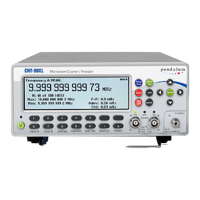Error Reporting
The counter will place a detected error in
its Error Queue. This queue is a FIFO
(First-In First-Out) buffer. When you
read the queue, the first error will come
out first, the last error last.
If the queue overflows, an overflow mes
-
sage is placed last in the queue, and fur
-
ther errors are thrown away until there is
room in the queue again.
n
Detecting Errors in the Queue
Bit 2 in the Status Byte Register shows if
the instrument has detected errors. It is
also possible to enable this bit for Service
Request on the GPIB. This can then inter-
rupt the GPIB controller program when
an error occurs.
n Read the Error/Event Queue
This is done with the :SYSTem:ERRor?
query.
Example:
SEND®
:SYSTem:ERRor?
READ¬
–100,8“Command8Error”
The query returns the error number fol
-
lowed by the error description.
+
Further description of all error
numbers can be found in the Er
-
ror Messages chapter
If more than one error occurred, the
query will return the error that occurred
first. When you read an error you will
also remove it from the queue. You can
read the next error by repeating the
query. When you have read all errors the
queue is empty, and the :SYSTem:ER
-
Ror? query will return:
0, “No error”
When errors occur and you do not read
these errors, the Error Queue may over
-
flow. Then the instrument will overwrite
the last error in the queue with the fol
-
lowing:
–350, “Queue overflow”
If more errors occur, they will be dis
-
carded.
n
Standardized Error Numbers
The instrument reports four classes of
standardized errors in the Standard Event
Status and in the Error/Event Queue as
shown in the following table:
Error Class Range of
Error Num-
bers
Standard
Event
Register
Command
Error
–100 to
–199
bit 5 - CME
Execution
Error
–200 to
–299
bit 4 - EXE
Device
Specific
Error
–300 to
–399
+100 to
+32767
bit 3 - DDE
Query Error
–400 to
–499
bit 2 -QYE
n
Command Error
This error shows that the instrument de
-
tected a syntax error.
Introduction to SCPI
Error Reporting 3-17

